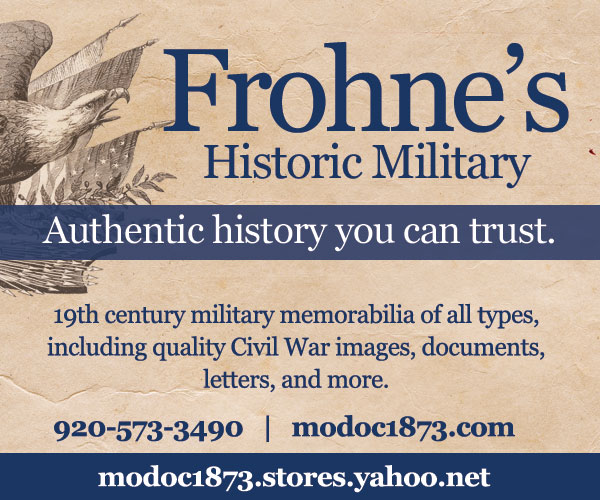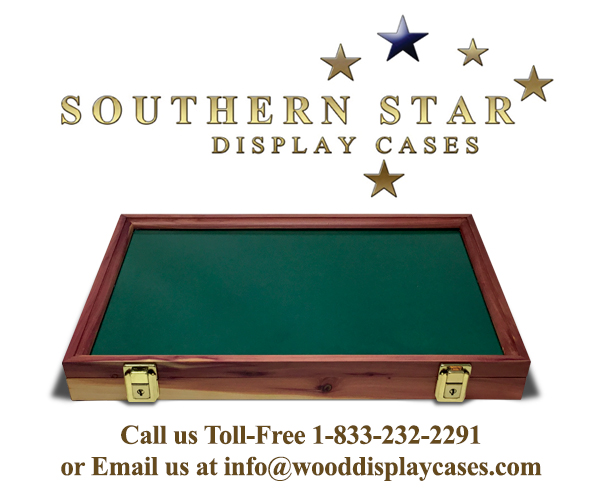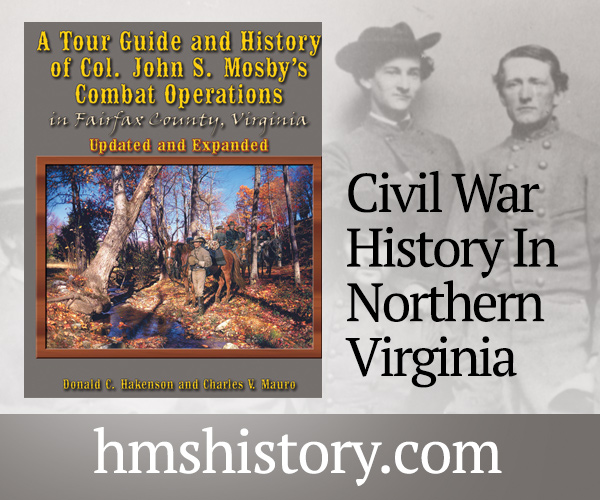The complete issue
Vol. VII, No. 6
(32 pages)
Print edition: Visit our store to check availability
Digital edition: Visit JSTOR.org to purchase
Subscribe to MI
Explore the MI Archives: Browse | Advanced search | Tutorial
Inside
Cover image
The oval image on the front cover is an unidentified Confederate who might be James D. Bulloch, who was in charge of the European shipbuilding program during the Civil War.
Editor’s Desk (p. 1)
The editor notes that an article in the current issue is topical based on continuing news from South Africa and Ireland. The upcoming 125th anniversary of the Battle of Bull Run will also be followed by Military Images; the editor provides a short overview of what readers can expect.
Mail Call (p. 2)
Letters to the editor include an explanation of label codes found on Military Images address labels and a clarification of the different cavalry regiments assigned to the U.S. Colored Troops are included. The editor also included a letter from William C. Davis which objected to the “Passing in Review” (March-April 1986) claim that persons other than the author selected the images for his work; the editor extended his apologies for the assertion and thanked Mr. Davis for his courtesy.
Passing in Review (p. 3)
Two publications are reviewed for the benefit of the readership in the issue. First is All for the Union edited by Robert Hunt Rhodes. Although subtitled to suggest it to be a history of the 2nd Rhode Island Volunteer Infantry, it is more a collection of diary entries, letters, and images from the collection of Elisha Hunt Rhodes, who served from 1861-1865. Second is Dear Friends at Home: The Letters and Diary of Thomas James Owen, Fiftieth New York Volunteer Regiment, During the Civil War edited by Dale E. Floyd. This volume does not come across as favorably as the first. It focuses mainly on a short period of time in 1864 from City Point during the siege of Petersburg, and does not provide much insight into the activities of the unit, but more on the political views of the author.
The 18th Louisiana Infantry: Acadians in Gray by Michael D. Jones (pp. 5-7)
This unit was much like other Confederate volunteers, but in one aspect they were very different. The men of the 18th Louisiana were French-speaking descendants of exiles sent out of Nova Scotia in 1755 as they refused to swear allegiance to the British king. The regiment represented the elite of Louisiana in the person of Colonel Alfred Mouton, who was a 1850 graduate of West Point and the son of a former Louisiana governor. It also represented the typical resident of the state: farmers, laborers, workmen from mostly the southern part of the state. The 18th Louisiana fought bravely at Shiloh, losing many at the Hornet’s Nest. They were sent then to the Trans-Mississippi Department, where they eventually took part in the Lafourche campaign and the Battle of Bayou Teche. While their last major battle was at Sabine Cross Roads, they remained together to become one of the last Confederate units to surrender in June 1865.
Pards: Photos of Friends, Partners, and Pals by Richard Carlile (pp. 8-13)
Twenty different images are presented of soldiers in the field or in the photographer’s studio. They were all comrades frequently displaying their arms, and all marking their Civil War friendships for posterity.
Chicago’s Wild Geese: Irish Volunteers in the Boer War by Kevin Young (pp. 14-15)
Some hatred die hard, and this article focuses on the continuing enmity felt by the Irish toward the British, this time taking the form of Irish-Americans who left Chicago to take up arms against the British in the Boer War in 1900. They fought with the deeply religious Boers, Protestants who looked upon the hard drinking and swearing Irish-Catholics from Chicago with some distain. However, the Boers needed fighters, and once the “Chicago Ambulance Corps” landed at Pretoria, they were handed guns under the leadership of John Y.F. Blake, a West Point graduate (1880) who had been in the 6th Cavalry and served, as had many of the Chicagoans, in the Spanish-American War. The Red Cross took away their flag and the American ambassador to South Africa protested, but the Chicagoans fought hard and provided rear guard support during Boer retreats. A monument to the first two casualties from the unit was erected in Mount Carmel Cemetery in Chicago to commemorate this group of Irish who took the fight to the British in South Africa.
Corps Badges of the Civil War, Part I: I, II, III, IV, V Corps by Wendell Lang (pp. 16-25)
This first of three articles about the Union corps badge begins with the story of how General Philip Kearny wanted to be able to identify “any of his officers who shirked or straggled” in the retreat across Virginia in the summer of 1862. He took his own red wool blanket and had his officers wear a red square for identification. After his death at the Battle of Chantilly on September 1, 1862, the men of his corps began to wear the badge as a memorial, gradually changing the shape until it was more of a diamond rather than a square. Joseph Hooker standardized this practice in March 1863. Today, our military wears identification patches to show their unit affiliation in an extension of this tradition. Twenty-six different images illustrate the different ways that the circle of I Corps, the trefoil (shamrock) of II Corps, the diamond of III Corps, the triangle of IV Corps, and the Maltese cross of V Corps. The insignia were often felt and sewn to soldiers’ kepis or worn on their uniform coats. Others were manufactured with bullion edging or made out of brass and attached with pin backs. The article shows the wide variety of corps badges and the many ways in which they were worn.
Stragglers (p. 25)
A soldier from Company H, 7th Pennsylvania Emergency Militia, a unit called up for the Battle of Antietam is the only image featured.
Whitfield’s Cavalry: A Texas-Arkansas Battalion in the Western Confederacy by Barry Mickey (pp. 27-29)
After routing Federal forces at Wilson’s Creek in August of 1861, commanding General Ben McCollough was in a hard place. His troops were from Arkansas and had not enlisted in the Confederate army, but had enlisted to serve in Missouri as state troopers. Only 18 of the men who fought at Wilson’s Creek decided to enlist as CSA soldiers. One small unit, Murphy’s Company of Arkansas Cavalry, was mustered in October 1861 and eventually merged with John W. Whitfield’s “Whitfield Rifles” from Texas and two other Texas companies to become the 4th Battalion, Texas Cavalry with Major Whitfield commanding. They fought against Union-supporting Indians and fought at Pea Ridge, before being reorganized as Whitfield’s Legion with the addition of seven more companies from Texas and one from Arkansas. Under the command of General Van Dorn this dismounted unit was sent to assist in Western Tennessee after Shiloh when the unit was again reorganized. This time, the Arkansans were grouped together and detached as Company H of the 1st Battalion Arkansas Cavalry. Both the Texas and Arkansas units saw extensive service, with the Arkansas fighting in pivotal engagements such as Vicksburg and the Texans fighting in the Battle of Iuka and the raid at Holly Springs, both in Mississippi.
Back Image
A cavalry trooper astride his mount graces the back cover.





































